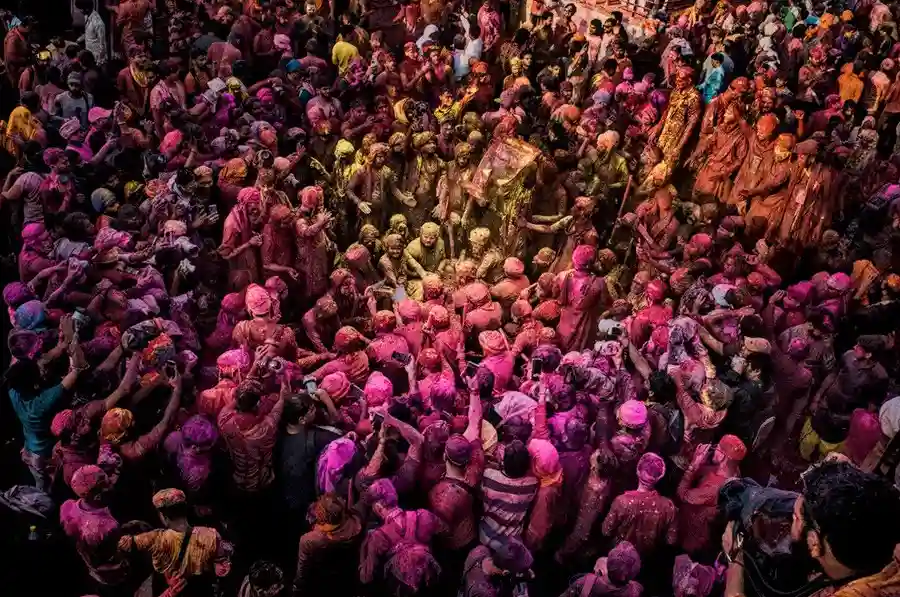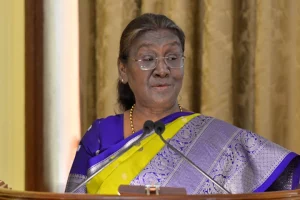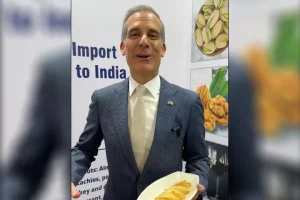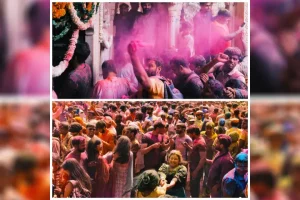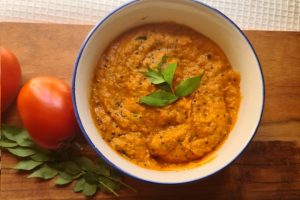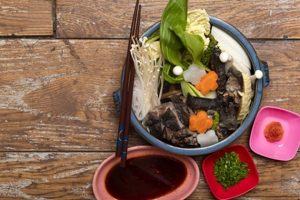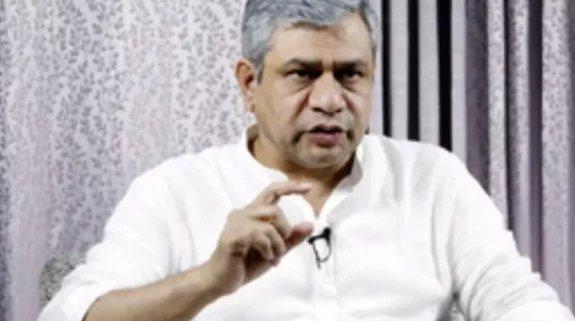Of the many Holi delights that you may have indulged in recently, the oldest is possibly the malpua.
Malpua is often regarded as the precursor to the more pervasive gulab jamun, which is a much later innovation, with new techniques and ingredients incorporated into an older culture of Indian cooking. Malpua, or pua, however, is one of those ancient sweets that we still find in our midst and it is most strongly associated with Holi celebrations across eastern UP and Bihar, including in the lands of Braj and Benares.
While the malpua is rich—it is soaked in syrup and saffron, post frying—its humbler cousin is the pua. A simple confection of sweetened batter that is fried, pua, along with rabdi, thickened milk, or even bhuna mutton is a traditional Holi delight, particularly in Bihar, where we find families frying the sweetish bread (and adding fruit like ripe banana to the batter) to pair with savoury gravies for the “Choti Holi” dinner, post Holika dahan, when the earth’s regenerative power is celebrated.
In Bihar, the land of ancient tales, Holi's colours and festivities never fail. #Malpua, a beloved sweet treat, adds to the joy.#Holi #BiharWaliHoli #food #taste_of_bihar pic.twitter.com/s51Sev2fPc
— Bihar Foundation (@biharfoundation) March 8, 2023
The pua– and thus malpua– has a history that goes back thousands of years. Its ancestor is the apupa, a cake of barley, steamed or fried, and dipped in honey that finds a mention in the Rig Veda, the oldest oral text of the Subcontinent. Barley (yava in Sanskrit) is the only cereal that is mentioned in the Rig Veda—it was a grain used even in the Indus Valley Civilisation and second in importance to rice in the Vedic period in northern India, when wheat was not yet popular.
Did you know? Malpua was born around 3000 years ago in the texts of Rigveda. The Vedic literature talked of a sweet called Apupa, a deep fried barley flour pancake, glazed with honey. Since then, the dish has gone through multiple culinary phases across the Indian Subcontinent. pic.twitter.com/ny0DWNk0nJ
— Odisha Millets Mission (@MilletsOdisha) October 3, 2022
There seems to be a scant difference between the technique of making the apupa and the pua and this is one of the dishes of India that survives virtually unchanged in India. Add a chashni or syrup of refined sugar instead of honey, and maida or refined flour instead of jau but otherwise the apupa is the pua. A more recent version of the pua is a pakori-like festive sweet known as gulgule, popular in the Indo-Islamic culture.
If the pua is one of the oldest Holi dishes, the thandai is young– a medieval concoction but based on the Ayurvedic practice of classifying food according to its guna and rasa. Cold milk is deemed to soothe the gut, mixed with the seeds of muskmelon, fennel, the thandai is the drink for spring, when the weather gets warmer; a therapeutic coolant.
Bhang meanwhile, the leaves of the cannabis plant, often added to thandai, does find a mention in the Atharvaveda, but it may not have been the same leaves, says historian KT Achaya, not quite the intoxicant. The narcotic properties seem to have found mentions only post the 10th century, and strikingly in the 16th-17th century travel accounts of foreigners.
Holi celebrations, all over India, are actually two distinct observations—one an agrarian bonfire marking the changing season, the dispelling of the dark winter and a more sedate worshipping of nature under a full moon of spring. (The myth of Holika and Prahlad is allusive of the dark winter being killed as the saplings of spring survive).
The festival of colours that comes on the morning after is more exuberant and inspired by an almost arcadian world of myth in Vrindavan. It is a forest idyll of love, beauty and a shringar ras of the larger Indian aesthetic and this finds expression in the north Indian, Braj Holi, of flowers and colours, songs and dance, rang and bhang. These motifs may have taken shape only in the post-Chaitanya period, when the Bhakti Saint revived Braj.
Greetings on the auspicious occasion of Gaur Poornima, celebrating the birth of Chaitanya Mahaprabhu – a pioneer of the Bhakti movement and an epitome of love, compassion, and devotion. pic.twitter.com/gsNqgvyq2l
— Anubhav Gupta (building TheDevAngel.com) (@GuptaAnubhav12) March 7, 2023
The sweets and snacks associated with this celebration are the chandrakala and kachori, which show influences of local cuisines of Bundelkhand, and neighbouring Rajasthan, just as it is the local tesu/palash flowers of the season that is soaked to make colour.
Chandrakala, round like the full moon after which it is named, with neat pinched edges, is in essence a mawa kachori of marwar, using in its filling khoya or mawa– milk solids, made from surplus milk of the countryside. The 12th century Manasollasa mentions the Golamu, where wheat dough kneaded with milk, ghee, sugar and powdered cardamom and black pepper is shaped into rounds and fried. This seems like an early version of the pua too, but also suggests a more festive version of the batti, the wheat dumpling that is so common in rural India, including Rajasthan, UP and Bihar and Karnataka (where ragi dumplings are cooked, millets being the common man’s staple there).
Gheeyar, Praghree, Chandrakala Gujiya, and Mawa Samosas … the ultimate Sindhi mithai spread for Holi! 😍
.
I am not a big fan of playing Holi. I dislike how so much water gets wasted and that the colours don’t wash off your skin, hair, and nails for… https://t.co/hQoGK2BJaS pic.twitter.com/bXRhzj9iOv— Rohit Haryani (@HungryMumbaikar) March 10, 2020
The kachori, finds a mention in texts of the 16th and 17th centuries, and as a snack was enjoyed as much by Mughal nobility as by other communities of Marwar, Delhi and Bundelkhand. From its origin ostensibly in Marwar, its cult spread to other parts of the Indo-Gangetic belt, particularly to towns such as Haridwar, Benares and in Bengal, where the wealthy marwaris built homes, close to the Ganga.
:’( Didn’t have a good one in years,maybe NJ has. RT @ceetee: The best kachori subzi in Benares is here. Lanka chowk. pic.twitter.com/RZmiy7q455
— Y. V. Reetesh (@Reetesh) March 3, 2013
The kachori, filled with dal and fried not baked, is likely an improvisation of the bati, the poor man’s dumpling. It also is a cousin of the samosa/samsa that was present in India by the 12th century, brought by cooks accompanying the Turkish-Afghan rulers of Delhi and finds a mention by Amir Khusro. But the Delhi samsa of that time was baked and filled with mince, the later day fried samosa filled with vegetables and lentils is an Indian invention influenced by the Rajasthani kachori.
The samsa/samosa however is called by its Persian name, the qottab, in the Ain-i-Akbari. Qottab is the Persian cousin of the Turkish samosa, its sweet version filled with almonds and pistachios, with the dough being more flaky, and the pastry dusted with sugar powder.
If the Chandrakala may have been inspired by the mawa kachori, the qottab/gottab perhaps inspired the goja/guja/gujiya.
How to prepare the Best Iranian Qottab Yazdi for 10 people#1touchfood #dessert #coffee #tea #juice #homemade #sweets #meat #food #vegetables #cooking #culinary #persian #iran #yazd #qottab #Qottab_Yazdi #persian #persianfoodhttps://t.co/F8B2Z9Wn4J pic.twitter.com/CSWdYdmTDr
— 1TouchFood (@1TouchFood1) March 3, 2023
The art of stretching the dough thin and layering it into parat or layers may have arrived from the middle east, finding subsequent expression not just in flaky fried dough sweets of India, which include the goja in Bengal but also the parathas of UP, which find no mention even in Mughal culinary tomes till the time of Shah Jahan, and were possibly an invention in Avadh.
Meanwhile, the half-moon gujiya (called a guja in some communities) is likely a medieval invention, combining the cult of the chandrakala and kachori as well as the idea of the qottab.
In the west, Greek and southern Spanish cuisine took up the art of creating parat or layers to create “phyllo” (literally, leaves), the flaky dough that is now synonymous with Greek and Turkish foods, but also finds expression in the mille feuille desserts (with puff pastry) of French cooking that started appearing only by the 17th century in cookbooks of western Europe.
In my family, taazi gobhi and baasi parathe (made the evening before, ostensibly for convenience since every one was busy paying colour on Holi mornings) made up the main Holi lunch, along with dahi-bade and kaanji, the fermented superstar of north Indian winter and spring.
Cauliflower, a winter delicacy, was an “English” vegetable, obviously incorporated into the food of the well-to-do as a special delicacy. The practice of making aloo ke chips by sun drying them, so prevalent in UP around Holi is also a more modern ritual, after large scale potato cultivation was introduced by the English in the 19th century—though the art of sun drying vegetables to preserve them (as also fermenting lentil dumplings—the badi/mangori tradition) is old.
But both dahi-bade and kaanji made with carrots or by soaking urad dal “bada” into the fermenting water of rai seeds have a far more ancient provenance, with a vada/bada like dish made with lentils finding mention in the Manasollasa. The vatika, made with split urad dal, ground and slightly fermented , seasoned with black pepper, cumin and hing, and deep fried are pretty much like the modern day medu vada. These were soaked in sour liquids, or yoghurt, yielding equivalents of both the kaanji bada and dahi bada.
India is known for its love of food and spices.
Mānasollāsa, a 12th-century sanskrit text, describes need to change cuisine and food with seasons, various methods of cooking, best blend of flavours, feel of various foods, planning and style of dining amongst other things. pic.twitter.com/LWqcBQmYZR
— Dr. M.F. Khan (@Dr_TheHistories) January 16, 2022
A festival such as Holi then clearly shows the culinary threads that can be traced back to an ancient culture, sophisticated in India, as well as the new layers of invention to those old dishes that have resulted in our modern celebrations.
Also Read: Indian cuisine’s Ayurvedic roots and other interesting facts
(Anoothi Vishal is the author of Mrs LC’s Table. She is also a columnist and food writer, specialising in cuisine history, culinary links between communities and regions. Views expressed are personal and exclusive to India Narrative)






